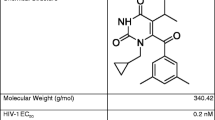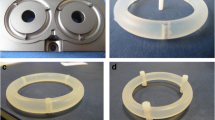Abstract
UC781 is a potent and poorly water-soluble nonnucleoside reverse transcriptase inhibitor being investigated as a potential microbicide for preventing sexual transmission of HIV-1. This study was designed to evaluate the in vivo release and pharmacokinetics of UC781 delivered from matrix-type intravaginal ring segments in rabbits. Three polymer matrices (polyurethane, ethylene vinyl acetate copolymer, and silicone elastomer) and two drug loadings (5 and 15 mg/segment) were evaluated in at least one of two independent studies for up to 28 days in vivo. Inter-study comparison of in vivo release, vaginal tissue, and plasma concentrations for similar formulations demonstrated good reproducibility of the animal model. Mean estimates for a 28-day in vivo release ranged from 0.35 to 3.17 mg UC781 per segment. Mean proximal vaginal tissue levels (adjacent to the IVR segment) were 8–410 ng/g and did not change significantly with time for most formulations. Distal vaginal tissue levels of UC781 were 6- to 49-fold lower than proximal tissue levels. Mean UC781 plasma levels were low for all formulations, at 0.09–0.58 ng/mL. All formulations resulted in similar UC781 concentrations in vaginal tissue and plasma, except the low loading polyurethane group which provided significantly lower levels. Loading dependent release and pharmacokinetics were only clearly observed for the polyurethane matrix. Based on these results, intravaginal ring segments loaded with UC781 led to vaginal tissue concentrations ranging from below to approximately two orders of magnitude higher than UC781’s EC50 under in vitro conditions (2.8 ng/mL), with little influence by polymer matrix or UC781 loading. Moreover, these findings support the use of rabbit vaginal pharmacokinetic studies in preclinical testing of microbicide intravaginal rings.




Similar content being viewed by others
References
Abdool Karim Q, Abdool Karim SS, Frohlich JA, Grobler AC, Baxter C, Mansoor LE. Effectiveness and safety of tenofovir gel, an antiretroviral microbicide, for the prevention of HIV infection in women. Science. 2010;329(5996):1168–74.
Grant RM, Lama JR, Anderson PL, McMahan V, Liu AY, Vargas L, et al. Preexposure chemoprophylaxis for HIV prevention in men who have sex with men. N Engl J Med. 2010;363(27):2587–99.
Balzarini J, Naesens L, Verbeken E, Laga M, Van Damme L, Parniak M, et al. Preclinical studies on thiocarboxanilide UC-781 as a virucidal agent. AIDS. 1998;12(10):1129–38.
Balzarini J, Brouwer WG, Dao DC, Osika EM, De Clercq E. Identification of novel thiocarboxanilide derivatives that suppress a variety of drug-resistant mutant human immunodeficiency virus type 1 strains at a potency similar to that for wild-type virus. Antimicrob Agents Chemother. 1996;40(6):1454–66.
Borkow G, Arion D, Wainberg MA, Parniak MA. The thiocarboxanilide nonnucleoside inhibitor UC781 restores antiviral activity of 3′-azido-3′-deoxythymidine (AZT) against AZT-resistant human immunodeficiency virus type 1. Antimicrob Agents Chemother. 1999;43(2):259–63.
Pelemans H, Esnouf R, De Clercq E, Balzarini J. Mutational analysis of trp-229 of human immunodeficiency virus type 1 reverse transcriptase (RT) identifies this amino acid residue as a prime target for the rational design of new non-nucleoside RT inhibitors. Mol Pharmacol. 2000;57(5):954–60.
Van Herrewege Y, Michiels J, Van Roey J, Fransen K, Kestens L, Balzarini J, et al. In vitro evaluation of nonnucleoside reverse transcriptase inhibitors UC-781 and TMC120-R147681 as human immunodeficiency virus microbicides. Antimicrob Agents Chemother. 2004;48(1):337–9.
Zussman A, Lara L, Lara HH, Bentwich Z, Borkow G. Blocking of cell-free and cell-associated HIV-1 transmission through human cervix organ culture with UC781. AIDS. 2003;17(5):653–61.
Fletcher P, Kiselyeva Y, Wallace G, Romano J, Griffin G, Margolis L, et al. The nonnucleoside reverse transcriptase inhibitor UC-781 inhibits human immunodeficiency virus type 1 infection of human cervical tissue and dissemination by migratory cells. J Virol. 2005;79(17):11179–86.
Borkow G, Barnard J, Nguyen TM, Belmonte A, Wainberg MA, Parniak MA. Chemical barriers to human immunodeficiency virus type 1 (HIV-1) infection: retrovirucidal activity of UC781, a thiocarboxanilide nonnucleoside inhibitor of HIV-1 reverse transcriptase. J Virol. 1997;71(4):3023–30.
Schwartz JL, Kovalevsky G, Lai JJ, Ballagh SA, McCormick T, Douville K, et al. A randomized six-day safety study of an antiretroviral microbicide candidate UC781, a non-nucleoside reverse transcriptase inhibitor. Sex Transm Dis. 2008;35(4):414–9.
Clark M, McCormick T, Doncel G, Friend D. Preclinical evaluation of UC781 microbicide vaginal drug delivery. Drug Delivery and Translational Research. 2011;1(2):175–82.
Ahrendt HJ, Nisand I, Bastianelli C, Gomez MA, Gemzell-Danielsson K, Urdl W, et al. Efficacy, acceptability and tolerability of the combined contraceptive ring, NuvaRing, compared with an oral contraceptive containing 30 microg of ethinyl estradiol and 3 mg of drospirenone. Contraception. 2006;74(6):451–7.
Novak A, de la Loge C, Abetz L, van der Meulen EA. The combined contraceptive vaginal ring, NuvaRing: an international study of user acceptability. Contraception. 2003;67(3):187–94.
Henriksson L, Stjernquist M, Boquist L, Cedergren I, Selinus I. A one-year multicenter study of efficacy and safety of a continuous, low-dose, estradiol-releasing vaginal ring (Estring) in postmenopausal women with symptoms and signs of urogenital aging. Am J Obstet Gynecol. 1996;174(1 Pt 1):85–92.
Nel A, Smythe S, Young K, Malcolm K, McCoy C, Rosenberg Z, et al. Safety and pharmacokinetics of dapivirine delivery from matrix and reservoir intravaginal rings to HIV-negative women. J Acquir Immune Defic Syndr. 2009;51(4):416–23.
Gupta KM, Pearce SM, Poursaid AE, Aliyar HA, Tresco PA, Mitchnik MA, et al. Polyurethane intravaginal ring for controlled delivery of dapivirine, a nonnucleoside reverse transcriptase inhibitor of HIV-1. J Pharm Sci. 2008;97(10):4228–39.
Johnson TJ, Gupta KM, Fabian J, Albright TH, Kiser PF. Segmented polyurethane intravaginal rings for the sustained combined delivery of antiretroviral agents dapivirine and tenofovir. Eur J Pharm Sci. 2010;39(4):203–12.
Fetherston SM, Malcolm RK, Woolfson AD. Controlled-release vaginal ring drug-delivery systems: a key strategy for the development of effective HIV microbicides. Therapeutic Delivery. 2010;1:785–802.
Woolfson AD, Malcolm RK, Toner CF, Morrow RJ, Lowry D, Jamil A, et al. Potential use of vaginal rings for prevention of heterosexual transmission of HIV: a controlled-release strategy for HIV microbicides. American Journal of Drug Delivery. 2006;4(1):7–20.
Malcolm K, Woolfson D, Russell J, Tallon P, McAuley L, Craig D. Influence of silicone elastomer solubility and diffusivity on the in vitro release of drugs from intravaginal rings. J Control Release. 2003;90(2):217–25.
Chien YW, Mares SE, Berg J, Huber S, Lambert HJ, King KF. Controlled drug release from polymeric delivery devices. III: In vitro–in vivo correlation for intravaginal release of ethynodiol diacetate from silicone devices in rabbits. J Pharm Sci. 1975;64(11):1776–81.
Damian F, Blaton N, Naesens L, Balzarini J, Kinget R, Augustijns P, et al. Physicochemical characterization of solid dispersions of the antiviral agent UC-781 with polyethylene glycol 6000 and Gelucire 44/14. Eur J Pharm Sci. 2000;10(4):311–22.
Doncel GF, Clark MR. Preclinical evaluation of anti-HIV microbicide products: new models and biomarkers. Antivir Res. 2010;88 Suppl 1:S10–8.
Barberini F, Correr S, De Santis F, Motta PM. The epithelium of the rabbit vagina: a microtopographical study by light, transmission and scanning electron microscopy. Arch Histol Cytol. 1991;54(4):365–78.
Barberini F, De Santis F, Correr S, Motta PM. The mucosa of the rabbit vagina: a proposed experimental model for correlated morphofunctional studies in humans. Eur J Obstet Gynecol Reprod Biol. 1992;44(3):221–7.
Rodriguez-Antolin J, Xelhuantzi N, Garcia-Lorenzana M, Cuevas E, Hudson R, Martinez-Gomez M. General tissue characteristics of the lower urethral and vaginal walls in the domestic rabbit. Int Urogynecol J Pelvic Floor Dysfunct. 2009;20(1):53–60.
Chien YW, Lambert HJ. Controlled drug release from polymeric delivery devices. II. Differentiation between partition-controlled and matrix-controlled drug release mechanisms. J Pharm Sci. 1974;63(4):515–9.
Acknowledgments
The support of Missy Peet and Devon Kyle of MPI Research, Inc., in coordination of the rabbit studies and sample bioanalytical analysis, is gratefully acknowledged. This work was funded by the United States Agency for International Development (USAID) under Cooperative Agreement GPO-A-00-08-00005-00. The views of the authors do not necessarily reflect those of USAID.
Author information
Authors and Affiliations
Corresponding author
Rights and permissions
About this article
Cite this article
Clark, M.R., Kiser, P.F., Loxley, A. et al. Pharmacokinetics of UC781-loaded intravaginal ring segments in rabbits: a comparison of polymer matrices. Drug Deliv. and Transl. Res. 1, 238–246 (2011). https://doi.org/10.1007/s13346-011-0032-4
Published:
Issue Date:
DOI: https://doi.org/10.1007/s13346-011-0032-4




